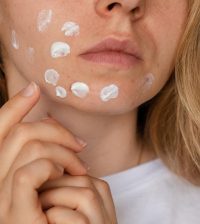- Trump Administration Withdraws Key ADA Documents
- Key HIV Care Teams Let Go, Putting Mothers and Children at Risk
- ‘Zero Suicide’ Model Leads To Fewer Suicides in Health Systems
- Stroke, Dementia, Depression Share Many Risk Factors
- Diet Drinks, Processed Foods Might Increase Type 2 Diabetes Risk
- Experimental Drug Can Slow MS Disability
- America’s ERs In Peril, Report Says
- Tasers Can Interfere With Heart Implants, Study Says
- Chronic Low Back Pain? Mindfulness Can Help
- Mehmet Oz Confirmed as Head of Centers for Medicare & Medicaid Services
Newer Sunscreens Can Better Match Your Skin Tone

Newer sunscreens that can match your skin tone may encourage more people to use sunscreen, an expert says.
“The lighter a person’s skin, the higher their risk for skin cancer,” said Dr. Henry Lim, former chair of dermatology at Henry Ford Hospital in Detroit. “While people with darker skin have a lower risk for skin cancer, it can still develop.”
But, he said in an American Academy of Dermatology (AAD) news release, the darker your skin tone, the higher your risk that UV rays and visible light from the sun will cause dark spots, also known as hyperpigmentation, on your skin.
“This is because darker skin has different types of melanin — the pigment produced by cells that give skin its color — than those with lighter skin,” Lim explained. “For that reason, we recommend sun protection for everyone.”
Broad-spectrum, water-resistant, tinted sunscreen with an SPF of 30 or higher will provide protection from both ultraviolet rays and visible light from the sun.
But, Lim said, some people avoid sunscreens, because many leave a noticeable white film on the skin.
“By tailoring the sunscreen formulations to an individual’s skin tone, people are more likely to protect themselves from the sun, therefore reducing their risk of skin cancer,” he said.
Lim recommended using a tinted sunscreen that contains iron oxides, which increase protection against visible light and ultraviolet A radiation.
But don’t stop with the sunscreen. Along with slathering it on and staying in the shade whenever possible, you also need to cover as much of your skin as possible when outdoors in order to reduce your skin cancer risk, according to the AAD.
Wear lightweight and long-sleeved shirts and pants, a wide-brimmed hat, sunglasses with UV protection, and shoes that cover your feet. When wearing sandals or flip-flops, or going barefoot, be sure to apply sunscreen to all exposed skin on your feet.
More information
The U.S. Centers for Disease Control and Prevention has more about sun safety.
SOURCE: American Academy of Dermatology, news release, March 25, 2022
Source: HealthDay
Copyright © 2025 HealthDay. All rights reserved.










